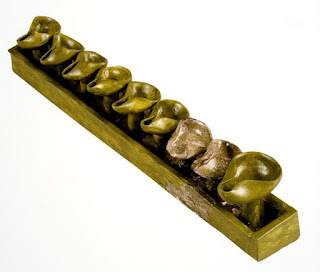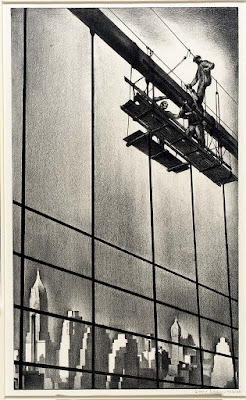Ceramic Hanukkah lamp found in Teruel, Spain. 15th century. Museo de Teruel inventory #7167. Photo from Birk, Transier, and Werner, Marcus; eds. The Jews of Europe in the Middle
Ages (Speyer: Historisches Museum der Pfalz Speyer, 2004), 182.
Ceramic Hanukkah lamp found in Lorca, Spain. 15th century. Lorca: Luces de Sefarad. Lights of Sepharad (Murcia, 2009), p 372.
by Samuel D. Gruber
Hanukkah is behind us, but not my embarrassment for a mistake on my holiday card that some readers may have received. The ceramic menorah that I labeled as coming from the important excavation of the former Jewish quarter in Lorca, Spain, is actually a similar menorah, also believed to be from the 15th century, that was found in 1977 in the area of the former Jewish quarter at Teruel and is now in the Museo de Teruel (inventory # 7167).
This menorah was seen in the United States in the 1992 exhibition Convivencia: Jews, Muslims, and Christians in Medieval Spain and will be seen again with other items associated with Jewish life in Spain before the 1492 in the upcoming exhibition Fractured Faiths: Spanish Judaism, The Inquisition, and New World Identities, opening May 22, 2016 (tentatively through December 31, 2016) at the New Mexico History Museum.
Here too, is the Lorca menorah, which is very
similar, but
glazed in green. This is one of many Hanukkah lamps and other lamp
fragments found in the excavation of houses in the former Jewish quarter
of Lorca, just below the castle. In all, fragments of least five
different Hanukkah lamps were found, indicating that lamps of this type
were commonly owned by Jewish households. Both the Teruel and Lorca Hanukkah lamps were fragmentary and have been substantially
restored to recreate their original appearance.
Asunción Blasco Martínez mentions in a essay in the Lorca catalog that the menorahs were stored "in cupboards built into the walls and in closets," but it is not clear whether this is supposition of based on the actual location of the archaeological finds. (In my perusing the available excavation reports I could not determine exactly where the menorah fragments were found).
Asunción Blasco Martínez mentions in a essay in the Lorca catalog that the menorahs were stored "in cupboards built into the walls and in closets," but it is not clear whether this is supposition of based on the actual location of the archaeological finds. (In my perusing the available excavation reports I could not determine exactly where the menorah fragments were found).
We don't know when and how these menorahs were broken - whether they
were discarded as trash before the expulsion of the Jews from Lorca at
the end of the 15th century, or deliberately at the time of departure,
or later over time either through pillaging of the site. The breaks do
not seem the result of natural causes, otherwise more connecting pieces
would have been found in close proximity.
At least one ceramic oil lamps from Hanukkah are known from antiquity. It is assumed that the tradition continued unbroken through the centuries, but examples from an intervening millennium are absent, so we cannot be sure.
Ceramic Hanukkah lamp fragments found in Lorca, Spain. 15th century. Photo from Lorca: Luces de
Sefarad. Lights of Sepharad (Murcia, 2009), p 380.
Hanukkah lamp. Found in Jerusalem. Illustrated in Jewish Encyclopedia, Vol VI, p 224
Illustration of a man lighting a Hanukkah menorah from Decisions of Isaiah of Trani the Younger (Pisqei Rabbi Yeshayah Aharon), produced in Central Italy in 1374 by Jekuthiel ben Solomon of Bologna (scribe). Names of artists are unknown. British Library Ms. Or 5024, fol. 19.
Forli Siddur, British Library, Ms. Add. 26968, fol. 101, Part 2, completed in northern Italy (Veneto?), 15th century. Is this menorah being lit outside the door or window of a house?
The use of the Hanukkah lamp in the home is mentioned in the Talmudic period, but no physical examples of such lamps have been found from before the 15th century. From as least the 11th century, there is also mention of the use of the Hanukkah lamp in the synagogue, and this use is explained in more detail by Joseph Caro in the 16th century.
There are a few 15th-century manuscript illuminations from Italy that represent a large menorah being lit, presumably in the synagogue. Thérèse and Mendel Metzger have noted that the Hanukkah menorahs with candles depicted in manuscripts that appear to be in synagogues are all of the types with a straight base upon which the candles are set, not in the traditional branched form familiar from depictions of the Temple menorah dating back to the Arch of Titus in Rome. These manuscript examples are Italian, so there could be a regional preference, but it more likely an adaptation from the earlier oil lamp type.
Lighting a Hanukkah menorah, Italy (Ferrara?), c1470. Israel Museum, Ms Rothschild 24, fol 113v, reproduced in T. and M. Metzger, Jewish Life in the Middle Ages: Illuminated Hebrew Manuscripts of the
Thirteenth to the Sixteenth Centuries, p. 70
As art historian Vivian Mann explains, synagogue menorahs are "said to have been introduced to accommodate travelers, whose needs likewise inspired the public recitation of kiddush, and sanctification over wine before the Sabbath. Other reasons (enumerated by Joseph Caro in Beit Yosef commentary to the Arbah Turim, cited by Mann) given were pirsumei nisah, publicizing the miracle of Hanukkah, and teaching congregants the correct order of the blessings."
Mann maintains, however, that "none of these rationales, however, account for the timing [late Ottonian/Early Romanesque period] of the appearance of synagogue Hanukkah lamps." She proposes that the introduction of large synagogue menorahs to commemorate Hanukkah could be a reaction to the appropriation of the Jewish menorah by Christianity in the Carolingian and Ottonian periods, when score of large menorahs were placed in churches symbolizing that the "Church was the successor to Judaism." The earliest (of more than fifty) surviving example is the menorah "dedicated to the Essen Minster by Abbess Mathilda, granddaughter of Otto the Great, around the year 1000."
In Northern and Central Europe, there was also a tradition of metal oil lamps especially made of the Hanukkah observance. Many of these have architectural motifs and it is on this basis that most of dated. A few examples, such a one in the Musée d'Art et d'Histoire du Judaïsme in Paris, have been dated to the 14th century, but most well known metal Hanukkah lamps are from the 15th and 16th century and later (and one should beware of the many copies for sale). All dates for menorahs should be accepted with caution. Unlike the Spanish ceramic menorahs, these bronze and brass menorahs would have been the exceptions, probably expensive and owned by wealthy Jews and kept as family heirlooms. The late Joseph Guttman suggested that all the bronze and brass lamps with triangular backs reputed to be medieval could, in fact, be from the 19th century.
Hanukah lamp. Germany, 14th cent. Bronze. Collection of Congregation Emanu-El, New York. Photo from Encyclopedia of Judaism I, fig. 3
Hanukkah lamps, 15th-16th centuries, possibly from Italy and Spain. Photo from Cantz, Jews of Europe in Middle Ages, p. 185
Sources:
Birk, Karin; Transier, Werner; Wener, Marcus; eds. The Jews of Europe in the Middle Ages with contributions by Alfred Haverkamp et al. (Speyer: Historisches Museum der Pfalz Speyer, 2004).
Carrillo, Juan Gallardo and González Ballesteros,
José Ángel “La Judería del Castillo de Lorca a Partir de las Evidencia
Arqueológicas,” in Lorca: Luces de
Sefarad. Lights of Sepharad (Murcia, 2009), 48-77.
Guttman, Joseph, "On Medieval Hanukkah Lamps," Artibus et Historiae, 1999, Vol. 20, No. 40 (1999), pp. 187-190
Lorca: Luces de Sefarad. Lights of Sepharad (Murcia, 2009), "Catalogo de Piezas," 372-385 [about Hanukkah lamp fragments]
Lorca: Luces de Sefarad. Lights of Sepharad (Murcia, 2009), "Catalogo de Piezas," 372-385 [about Hanukkah lamp fragments]
Mann, Vivian, “Towards an Iconography of Medieval
Diaspora Synagogues,” in C. Cluse, ed. The
Jews of Europe in the Middle Ages (Tenth to Fifteenth Centuries (Proceedings of
the International Symposium held at Speyer, 20-25 October 2002, (Brepols,
2004), 341-351.
Martínez, Asunción Blasco, "La Vida en la Juderia," in Lorca: Luces de
Sefarad. Lights of Sepharad (Murcia, 2009), 22-45.
Metzger, Thérèse and Mendel, 1982. Jewish Life in the Middle Ages: Illuminated Hebrew Manuscripts of the
Thirteenth to the Sixteenth Centuries (Secaucus, N.J.: Chartwell Books,
1982, 70-71, 74.






















